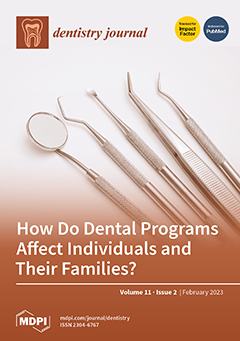Open AccessFeature PaperArticle
The Impact of Dental Care Programs on Individuals and Their Families: A Scoping Review
by
Abdulrahman Ghoneim, Violet D’Souza, Arezoo Ebnahmady, Kamini Kaura Parbhakar, Helen He, Madeline Gerbig, Audrey Laporte, Rebecca Hancock Howard, Noha Gomaa, Carlos Quiñonez and Sonica Singhal
Cited by 2 | Viewed by 2888
Abstract
Background: Despite significant global improvements in oral health, inequities persist. Targeted dental care programs are perceived as a viable approach to both improving oral health and to address inequities. However, the impacts of dental care programs on individual and family oral health outcomes
[...] Read more.
Background: Despite significant global improvements in oral health, inequities persist. Targeted dental care programs are perceived as a viable approach to both improving oral health and to address inequities. However, the impacts of dental care programs on individual and family oral health outcomes remain unclear. Objectives: The purpose of this scoping review is to map the evidence on impacts of existing dental programs, specifically on individual and family level outcomes. Methods: We systematically searched four scientific databases, MEDLINE, EMBASE, CINAHL, and Sociological Abstracts for studies published in the English language between December 1999 and November 2021. Search terms were kept broad to capture a range of programs. Four reviewers (AG, VD, AE, and KKP) independently screened the abstracts and reviewed full-text articles and extracted the data. Cohen’s kappa inter-rater reliability score was 0.875, indicating excellent agreement between the reviewers. Data were summarized according to the PRISMA statement. Results: The search yielded 65,887 studies, of which 76 were included in the data synthesis. All but one study assessed various individual-level outcomes (n = 75) and only five investigated family outcomes. The most common program interventions are diagnostic and preventive (n = 35, 46%) care, targeted children (n = 42, 55%), and delivered in school-based settings (n = 28, 37%). The majority of studies (n = 43, 57%) reported a significant improvement in one or more of their reported outcomes; the most assessed outcome was change in dental decay (n = 35). Conclusions: Dental care programs demonstrated effectiveness in addressing individual oral health outcomes. However, evidence to show the impact on family-related outcomes remains limited and requires attention in future research.
Full article
►▼
Show Figures






